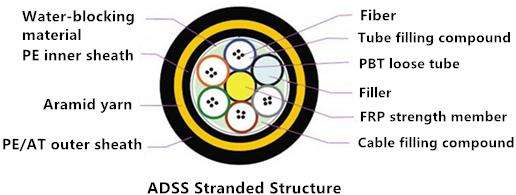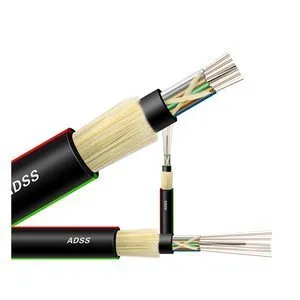Discover the Fascinating World of ADSS Fiber Cable: Everything You Need to Know

ADSS fiber cable, also known as All-Dielectric Self-Supporting fiber cable, is a crucial component of modern telecommunications infrastructure. Its innovative design allows it to support its own weight without the need for additional metal elements, making it ideal for aerial and duct applications. The high mechanical strength of ADSS fiber cable enables it to withstand strong electric currents, ensuring reliable performance in various environmental conditions. From pole-to-building installations to long-span applications, ADSS fiber cable offers versatile solutions for robust and efficient connectivity.
What is ADSS Fiber Cable?
ADSS fiber cable, also known as All-Dielectric Self-Supporting fiber cable, is a revolutionary solution for modern telecommunications infrastructure. Its unique design allows it to provide robust connectivity without the need for additional metal elements, making it ideal for various aerial and duct applications. Let's delve into the fundamental aspects of ADSS fiber cable to understand its composition and characteristics.
Definition and Basics
ADSS fiber cable is primarily composed of dielectric materials that offer high tensile strength and durability. The core material consists of optical fibers surrounded by protective layers, ensuring reliable transmission of data signals over extended distances. Its innovative design eliminates the need for metallic components, making it resistant to electromagnetic interference.
Material Composition
The primary components of ADSS fiber cable include:
Fiber Optic Core: Consists of glass or plastic fibers that transmit data signals.
Dielectric Strength Members: Provide structural support without using conductive materials.
Outer Sheath: Protects the internal components from environmental factors such as moisture and UV radiation.
Mechanical Strength
ADSS fiber cable exhibits exceptional mechanical strength, enabling it to withstand strong electric currents and environmental stressors. Its robust construction ensures reliable performance in challenging conditions, making it suitable for a wide range of applications.
Structure and Characteristics
The structure and characteristics of ADSS fiber cable contribute to its resilience and efficiency in diverse environments.
Weather Resistance
The outer sheath of ADSS fiber cable provides excellent protection against harsh weather conditions, including extreme temperatures, moisture, and UV exposure. This weather-resistant feature ensures long-term reliability in outdoor installations.
Electrical Interference
Due to its non-metallic composition, ADSS fiber cable offers inherent resistance to electrical interference. This characteristic makes it well-suited for areas with high-voltage power lines or electromagnetic fields.
Key Features of ADSS Fiber Cable
ADSS fiber cable boasts a range of key features that make it an indispensable component of modern telecommunications infrastructure. Its innovative design and exceptional characteristics contribute to its widespread use in various applications, from urban settings to long-span installations.
All-Dielectric Self-Supporting Design
The All-Dielectric Self-Supporting (ADSS) design sets this fiber cable apart as a reliable and versatile solution for aerial and duct applications. By incorporating high-strength dielectric materials, ADSS fiber cable eliminates the need for metallic components, providing robust connectivity while supporting its own weight between structures. This unique design ensures efficient installation and maintenance, making it an ideal choice for diverse deployment scenarios.

Resistance to Environmental Factors
Weather Resistance
One of the standout features of ADSS fiber cable is its exceptional resistance to environmental factors. The outer sheath provides a protective barrier against harsh weather conditions, including extreme temperatures, moisture, and UV exposure. This weather-resistant attribute ensures the longevity and reliability of ADSS fiber cable in outdoor installations, making it well-suited for demanding environments.
Electrical Interference
ADSS fiber cable offers inherent resistance to electrical interference due to its non-metallic composition. This characteristic makes it particularly suitable for areas with high-voltage power lines or electromagnetic fields. The ability to maintain signal integrity in the presence of electrical interference enhances the overall performance and reliability of ADSS fiber cable in challenging operational environments.
Longevity and Durability
The longevity and durability of ADSS fiber cable are key factors that contribute to its widespread adoption across various telecommunications applications. Its robust construction and weather-resistant properties ensure consistent performance over extended periods, reducing the need for frequent maintenance or replacements. Whether deployed in urban areas with high-density networks or expansive rural settings, ADSS fiber cable delivers long-term connectivity solutions that meet the demands of modern communication infrastructure.
Applications of ADSS Fiber Cable
ADSS fiber cable plays a pivotal role in various applications, offering reliable connectivity solutions for diverse telecommunications needs. Its versatility and robust design make it an ideal choice for power line communication, telecommunication networks, and specialized installations.
Power Line Communication
ADSS fiber cable serves as a critical component in power line communication systems, facilitating the transmission of data signals alongside electrical distribution networks. By integrating optical fibers into power line infrastructure, ADSS fiber cable enables efficient communication between substations, transformers, and other grid components. This seamless integration enhances grid monitoring, control capabilities, and smart grid functionalities, contributing to the advancement of modern utility networks.
Telecommunication Networks
In the realm of telecommunication networks, ADSS fiber cable offers unparalleled performance and reliability in both urban and rural settings.
Urban Areas
Within urban environments, where high-density network deployments are prevalent, ADSS fiber cable provides a cost-effective solution for establishing robust connectivity. Its ability to support high-bandwidth data transmission over extended distances makes it well-suited for metropolitan areas with complex network architectures. Whether deployed along city streets or integrated into existing infrastructure, ADSS fiber cable ensures seamless connectivity for urban dwellers and businesses.
Rural Expansion
The expansion of telecommunication networks into rural areas requires solutions that can withstand environmental challenges while delivering consistent performance. ADSS fiber cable meets these demands by offering long-span capabilities and resistance to harsh weather conditions. Its all-dielectric self-supporting design enables efficient installation across vast rural landscapes without the need for additional support structures. As a result, ADSS fiber cable facilitates the extension of reliable connectivity to remote communities, empowering them with access to essential communication services.
Specialized Installations
In addition to traditional applications, ADSS fiber cable caters to specialized installations that demand exceptional durability and resilience.
Long-Span Installations
For projects requiring extended distances between support structures, such as river crossings or expansive terrain coverage,** ADSS fiber cable** offers an optimal solution. With pole span lengths ranging from 100m to 700m,** ADSS-D fiber optic cable** provides versatile options for long-span installations. This capability makes it well-suited for infrastructure projects that require seamless connectivity over challenging geographic features.
Harsh Environments
Deployments in harsh environments necessitate cables that can withstand extreme conditions while maintaining reliable performance. ADSS fiber cable's weather-resistant properties make it an ideal choice for installations in coastal regions, deserts,** or areas prone to inclement weather events. Its ability to endure temperature variations,** moisture exposure**, and UV radiation ensures uninterrupted connectivity even in the most demanding operational settings.

Choosing the Right ADSS Fiber Cable
Considerations for Selection
When choosing the right ADSS fiber cable for a specific application, several key considerations come into play to ensure optimal performance and reliability. These considerations encompass factors such as span length and environmental conditions, which significantly impact the suitability of the cable for its intended deployment.
Span Length
The span length of ADSS fiber cable plays a crucial role in determining its compatibility with different installation scenarios. It is essential to assess the distance between support structures to select a cable that can effectively span the required distance without compromising performance. For instance, shorter span lengths may be suitable for urban settings with closely spaced poles, while longer span lengths are necessary for expansive rural landscapes or infrastructure projects that involve river crossings. By evaluating the specific span requirements, it becomes possible to choose an ADSS fiber cable that aligns with the spatial parameters of the installation environment.
Environmental Conditions
Environmental conditions exert a significant influence on the longevity and performance of ADSS fiber cable. Assessing factors such as temperature variations, moisture levels, UV exposure, and other climatic elements is essential to determine the most suitable cable for a given location. Cables deployed in coastal regions or areas prone to extreme weather events require robust weather-resistant properties to withstand environmental challenges effectively. Similarly, installations in desert environments or regions with high UV radiation necessitate cables with enhanced durability against such conditions. By carefully considering the environmental context of the deployment site, it becomes feasible to select an ADSS fiber cable that can endure and thrive in challenging operational settings.
Installation Tips
Efficient installation practices are instrumental in maximizing the effectiveness and longevity of ADSS fiber cable deployments. Implementing appropriate installation techniques ensures that the cable is securely positioned and maintained for optimal functionality throughout its service life.
Professional Expertise: Engaging experienced professionals who specialize in aerial and duct installations can significantly enhance the quality and reliability of ADSS fiber cable deployments.
Tension Control: Maintaining proper tension during installation is critical to prevent excessive stress on the cable and ensure consistent performance over time.
Environmental Assessment: Conducting a thorough assessment of environmental factors at the installation site helps identify potential challenges and implement preemptive measures to mitigate their impact.
Regular Inspections: Establishing a routine inspection schedule allows for proactive identification of any issues or vulnerabilities that may arise post-installation, enabling timely maintenance interventions.
By adhering to these installation tips, stakeholders can optimize the deployment process and contribute to the long-term efficacy of ADSS fiber cable solutions across diverse applications.
In conclusion, the significance of ADSS fiber cable in modern telecommunications cannot be overstated. Its innovative design and robust features make it an indispensable component for diverse applications. From power line communication to urban and rural telecommunication networks, ADSS fiber cable offers reliable connectivity solutions that endure challenging environmental conditions. As technology continues to advance, exploring the potential of ADSS fiber cable solutions becomes increasingly crucial for enhancing connectivity and infrastructure resilience. Embracing the versatility and durability of ADSS fiber cable opens doors to a new era of efficient and sustainable telecommunications solutions.
See Also
Discovering the Heart of ADSS Fiber Cable: Reliability, Efficiency, and Innovation
2024 Future Development Trends in Fiber Optic Industry
Exploring Singlemode and Multimode Fiber Optic Jumper Cables for FTTA & PTTA Networks
Understanding Preconnector and Fastconnect Technology in Fiber Optic Networks
Mastering SC and LC Fast Connectors for Fiber Optic Applications
About US
Follow Us
AnetFiber company's main products are indoor and outdoor optical fiber cables, outdoor waterproof pre-connected fiber-to-the-home products, PLC optical fiber splitters, optical fiber jumpers and pigtails, MTP®/MPO high-density big data product solutions, optical fiber field quick connectors and research and development molding, injection molding and production of optical fiber distribution boxes, optical fiber chassis cabinets, the market has expanded to the world, Europe, America, Asia, the Middle East and Latin America.
Address
Shenzhen City, Baoan District, Yanluo Street, Tangxiayong Community, Yangyong Industrial Road, Tonggangda New Energy Vehicle Park 406
Contacts
+86 199 2655 3586

